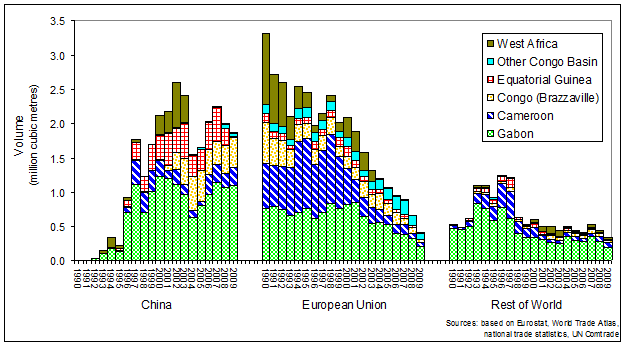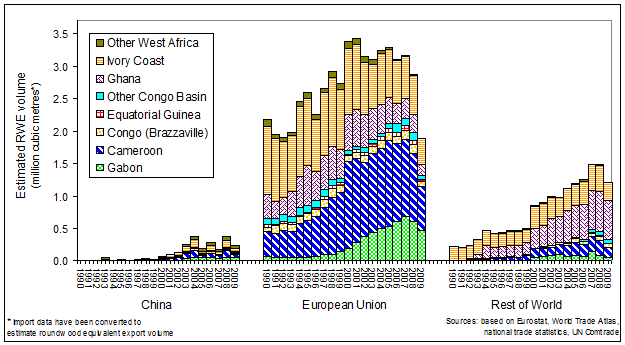|
|
||
|
|
||
|
Exports by, and imports from, Africa |
||
|
West Africa
and the Congo Basin - exports of timber*
other than logs to China, the EU and elsewhere The share
of particular destination countries in the tropical timber exports
of West Africa and the Congo Basin |
||
|
Clearly, China's interest is solely in logs (particularly for the manufacture and export of plywood and flooring). Although this is flagrantly contrary to the intent of the law, China (and other countries) makes fuller use of the logs milled than is likely to be the case in these producer countries. In this respect, breaking the law might seem better for the forest than compliance. However, a substantial tax should be levied on those log exports - in effect a fine - and this should be invested (transparently) in protecting the region's natural forest. Such as tax would enable those exports to be regarded as legal - but in this one respect only. Contrary to what misleading statistics of the FAO and others imply, the natural forest of interest for commercial timber operations(which are predominantly export-oriented) in the region is rapidly becoming exhausted - particularly where chinese logging interests are greatest. Exports by
Africa Prior to 1990,
Ivory Coast was Africa's leading exporter
of tropical timber. The quantity that it exported during the period
shown exhibits a slight declining trend. In contrast, Ghana's
exports of tropical timber exhibit a slight rising trend, but remain
well below those of Ivory Coast (the state of whose forests and timber
industry those of Ghana appear most closely to resemble). Liberia re-emerged as the region's fourth largest exporter in 2000 and had its highest ever level of exports in 2002. The exports of tropical timber from Congo (Brazzaville), having fallen during the 1990s, rose to near record levels during 2003. Equatorial Guinea has been a major exporter since the mid-1990s. Those from the Democratic Republic of Congo (formerly Zaire) are no longer substantial. Imports from
Africa For a rather longer
time, markets in France, Italy, Spain, and to a lesser extent Portugal
have dominated the trade. This geographic concentration in the Southern
EU suggests a role for the EU in regulating imports - in ways that
do not dilute demands (which appear rather more widespread in Northern
Europe) for improvements in both governance and socio-environmental
standards in producer countries. Of course, some of the imports by
the Southern EU are subsequently exported, for example, once they
have been transformed. The markets of
the Southern EU appear to have been depressed in 1993 - just prior
to a 50% devaluation of the predominant local currency of the region's
producer countries - but otherwise their imports have been fairly
flat. |
||
|
Copyright
globaltimber.org.uk
|



